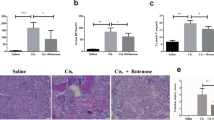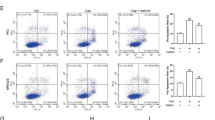Summary
Biliverdin (BV) has long been thought to be a cytotoxic metabolic waste product. It has also been demonstrated to have important cytoprotective functions during oxidative stress. The present study aimed to examine the cytoprotective effect of BV on NRK-52E cells, a proximal tubular cell line derived from rat kidney. Cells were treated with 50 µmol/L cisplatin for 24 h (cisplatin group) or pre-treated with BV for 30 min, then with 50 µmol/L cisplatin for 24 h (cisplatin+BV group). Those given no treatment served as a control. Cell apoptosis was evaluated by flow cytometry and cell viability by Cell Counting Kit-8 (CCK-8). The protein expressions of cleaved caspase3, Bax and Bcl-2 were assessed by Western blotting. Reactive oxygen species (ROS) levels were measured using carboxydichlorodihydrofluorescein diacetate (H2DCF). The results showed that cisplatin induced the apoptosis of NRK-52E cells, decreased cell viability, and increased the formation of ROS by upregulating the expression of cleaved caspase3 and Bax and decreasing Bcl-2 protein expression. These effects could be significantly reversed by pretreatment with BV. It was concluded that BV can protect against cisplatin-induced cell apoptosis through the anti-oxidative effects.
Similar content being viewed by others
References
Bagshaw SM. Short-and long-term survival after acute kidney injury. Nephrol Dial Transplant, 2008,23(7): 2126–2128
Chertow GM, Burdick E, Honour M, et al. Acute kidney injury, mortality, length of stay, and costs in hospitalized patients. J Am Soc Nephrol, 2005,16(11):3365–3370
Togel FE, Westenfelder C. Kidney protection and regeneration following acute injury: progress through stem cell therapy. Am J Kidney Dis, 2012,60(6):1012–1022
Waikar SS, Liu KD, Chertow GM. Diagnosis, epidemiology and outcomes of acute kidney injury. Clin J Am Soc Nephrol, 2008,3(3):844–861
Fukasawa H, Furuya R, Yasuda H, et al. Anti-cancer agent-induced nephrotoxicity. Anticancer Agents Med Chem, 2014,14(7):921–927
Peres LA, da Cunha AD, Jr. Acute nephrotoxicity of cisplatin: molecular mechanisms. J Bras Nefrol, 2013, 35(4):332–340
Camano S, Lazaro A, Moreno-Gordaliza E, et al. Cilastatin attenuates cisplatin-induced proximal tubular cell damage. J Pharmacol Exp Ther, 2010,334(2):419–429
dos Santos NA, Carvalho Rodrigues MA, Martins NM, et al. Cisplatin-induced nephrotoxicity and targets of nephroprotection: an update. Arch Toxicol, 2012, 86(8):1233–1250
Pabla N, Dong Z. Cisplatin nephrotoxicity: mechanisms and renoprotective strategies. Kidney Int, 2008,73(9): 994–1007
Sanchez-Gonzalez PD, Lopez-Hernandez FJ, Lopez-Novoa JM, et al. An integrative view of the pathophysiological events leading to cisplatin nephrotoxicity. Crit Rev Toxicol, 2011,41(10):803–821
Stocker R, Yamamoto Y, McDonagh AF, et al. Bilirubin is an antioxidant of possible physiological importance. Science, 1987,235(4792):1043–1046
Baranano DE, Rao M, Ferris CD, et al. Biliverdin reductase: a major physiologic cytoprotectant. Proc Natl Acad Sci USA, 2002,99(25):16093–16098
Lerner-Marmarosh N, Miralem T, Gibbs PE, et al. Human biliverdin reductase is an ERK activator; hBVR is an ERK nuclear transporter and is required for MAPK signaling. Proc Natl Acad Sci USA, 2008,105(19):6870–6875
Maines MD. New insights into biliverdin reductase functions: linking heme metabolism to cell signaling. Physiology, 2005,20(6):382–389
Kapitulnik J, Maines MD. Pleiotropic functions of biliverdin reductase: cellular signaling and generation of cytoprotective and cytotoxic bilirubin. Trends Pharmacol Sci, 2009,30(3):129–137
Lerner-Marmarosh N, Shen J, Torno MD. Human biliverdin reductase: a member of the insulin receptor substrate family with serine/threonine/tyrosine kinase activity. Proc Natl Acad Sci USA, 2005,102(20):7109–7114
Sedlak TW, Snyder SH. Bilirubin benefits: cellular protection by a biliverdin reductase antioxidant cycle. Pediatrics, 2004,113(6):1776–1782
Bulmer AC, Blanchfield JT, Coombes JS, et al. In vitro permeability and metabolic stability of bile pigments and the effects of hydrophilic and lipophilic modification of biliverdin. Bioorg Med Chem, 2008,16(7):3616–3625
Sheikh-Hamad D, Cacini W, Buckley AR, et al. Cellular and molecular studies on cisplatin-induced apoptotic cell death in rat kidney. Arch Toxicol, 2004,78(3):147–155
Boulikas T, Vougiouka M. Cisplatin and platinum drugs at the molecular level. Oncol Rep, 2003,10(6):1663–1682
Sugimoto R, Tanaka Y, Noda K, et al. Preservation solution supplemented with biliverdin prevents lung cold ischaemia/reperfusion injury. Eur J Cardiothorac Surg, 2012,42(6):1035–1041
Ikeda N, Inoguchi T, Sonoda N, et al. Biliverdin protects against the deterioration of glucose tolerance in db/db mice. Diabetologia, 2011, 54(8):2183–2191
Bai B, Liu Y, You Y, et al. Intraperitoneally administered biliverdin protects against UVB-induced skin photodamage in hairless mice. J Photochem Photobiol B, 2015,144:35–41
Yamashita T, Deguchi K, Sehara Y, et al. Therapeutic strategy for ischemic stroke. Neurochem Res, 2009,34(4): 707–710
Bisht K, Tampe J, Shing C, et al. Endogenous tetrapyrroles influence leukocyte responses to lipopolysaccharide in human blood: pre-clinical evidence demonstrating the anti-inflammatory potential of biliverdin. J Clin Cell Immunol, 2014,5(218):1000218
Author information
Authors and Affiliations
Corresponding author
Rights and permissions
About this article
Cite this article
Lv, Q., Yao, Y., Wang, W. et al. Biliverdin protects against cisplatin-induced apoptosis of renal tubular epithelial cells. J. Huazhong Univ. Sci. Technol. [Med. Sci.] 36, 48–52 (2016). https://doi.org/10.1007/s11596-016-1540-8
Received:
Revised:
Published:
Issue Date:
DOI: https://doi.org/10.1007/s11596-016-1540-8




